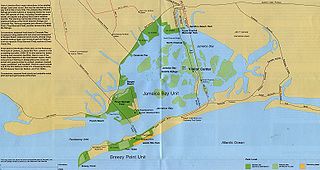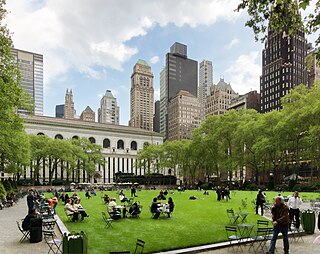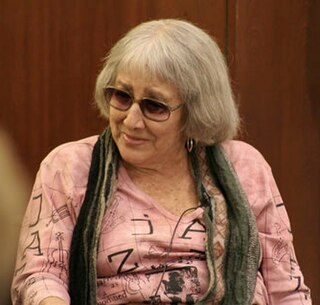Related Research Articles

Jamaica Bay is an estuary on the southern portion of the western tip of Long Island, in the U.S. state of New York. The estuary is partially man-made, and partially natural. The bay connects with Lower New York Bay to the west, through Rockaway Inlet, and is the westernmost of the coastal lagoons on the south shore of Long Island. Politically, it is primarily divided between the boroughs of Brooklyn and Queens in New York City, with a small part touching Nassau County.

Jamaica Bay Wildlife Refuge is a wildlife refuge in New York City managed by the National Park Service as part of Gateway National Recreation Area. It is composed of the open water and intertidal salt marshes of Jamaica Bay. It lies entirely within the boundaries of New York City, divided between the boroughs of Brooklyn to the west and Queens to the east.

The Gowanus Canal is a 1.8-mile-long (2.9 km) canal in the New York City borough of Brooklyn, on the westernmost portion of Long Island. Once a vital cargo transportation hub, the canal has seen decreasing use since the mid-20th century, parallel with the decline of domestic waterborne shipping. It continues to be used for occasional movement of goods and daily navigation of small boats, tugs and barges.

Bryant Park is a 9.6-acre (39,000 m2) public park located in the New York City borough of Manhattan. Privately managed, it is located between Fifth Avenue and Avenue of the Americas and between 40th and 42nd Streets in Midtown Manhattan. The eastern half of Bryant Park is occupied by the Main Branch of the New York Public Library. The western half, which contains a lawn, shaded walkways, and amenities such as a carousel, is located entirely over an underground structure that houses the library's stacks. The park hosts several events, including a seasonal "Winter Village" with an ice rink and shops during the winter.

Broad Channel is a neighborhood in the southern portion of the New York City borough of Queens. It occupies the southern portion of Rulers Bar Hassock, the only inhabited island in Jamaica Bay.

An artificial reef (AR) is a human-created freshwater or marine benthic structure. Typically built in areas with a generally featureless bottom to promote marine life, it may be intended to control erosion, protect coastal areas, block ship passage, block the use of trawling nets, support reef restoration, improve aquaculture, or enhance scuba diving and surfing. Early artificial reefs were built by the Persians and the Romans.
Gregg Bendian is an American jazz drummer, percussionist, pianist, and composer.
Bayside Cemetery is a Jewish cemetery at 80-35 Pitkin Avenue in Ozone Park, Queens, New York City. It covers about 12 acres (4.9 ha) and has about 35,000 interments. It is bordered on the east by Acacia Cemetery, on the north by Liberty Avenue, on the west by Mokom Sholom Cemetery, and on the south by Pitkin Avenue.

The Great Pacific garbage patch is a garbage patch, a gyre of marine debris particles, in the central North Pacific Ocean. It is located roughly from 135°W to 155°W and 35°N to 42°N. The collection of plastic and floating trash originates from the Pacific Rim, including countries in Asia, North America, and South America.

The New York Aquarium is the oldest continually operating aquarium in the United States, located on the Riegelmann Boardwalk in Coney Island, Brooklyn, New York City. It was founded at Castle Garden in Battery Park, Manhattan, in 1896, and moved to Coney Island in 1957. The aquarium is operated by the Wildlife Conservation Society (WCS) as part of its integrated system of four zoos and one aquarium, most notably the Bronx Zoo. It is accredited by the Association of Zoos and Aquariums (AZA). As part of WCS, the aquarium's mission is to save wildlife and wild places worldwide through science, conservation action, education, and inspiring people to value nature.

Eugenie Clark, popularly known as The Shark Lady, was an American ichthyologist known for both her research on shark behavior and her study of fish in the order Tetraodontiformes. Clark was a pioneer in the field of scuba diving for research purposes. In addition to being regarded as an authority in marine biology, Clark was popularly recognized and used her fame to promote marine conservation.

Jujamcyn Theaters LLC, formerly the Jujamcyn Amusement Corporation, is a theatrical producing and theatre-ownership company in New York City. For many years Jujamcyn was owned by James H. Binger, former Chairman of Honeywell, and his wife, Virginia McKnight Binger. The organization is now held by its president, Jordan Roth, and president emeritus, Rocco Landesman.

Osborne Reef is an artificial reef off the coast of Fort Lauderdale, Florida. Originally constructed of concrete jacks, it was the subject of an ambitious expansion project utilizing old and discarded tires. The expansion ultimately failed, and the reef has come to be considered an environmental disaster—ultimately doing more harm than good in the coastal Florida waters.
The Mannahatta Project is a Wildlife Conservation Society research project in historical ecology led by landscape ecologist Eric W. Sanderson that principally ran for 10 years, from 1999-2009, reconstructing the island at the point of first contact between the Dutch ship Halve Maen and the Lenape in 1609. The work culminated in the publication of Mannahatta: A Natural History of New York City in 2009, and has subsequently developed as the Welikia Project and in influence on other environmental initiatives.

The PS Washington Irving was a 4,000-short-ton (3,600 t) sidewheel day boat and the flagship of the Hudson River Day Line that operated on the Hudson River from 1913 to 1926.

The Syrian Arab Red Crescent (SARC) is a humanitarian nonprofit organization. Its headquarters are in the Syrian capital city of Damascus. The society was founded in Damascus, Syria in 1942, and admitted to the International Committee of the Red Cross (ICRC) in 1946. Some of founders included were Abdul-Kader Zahra, Jamil Kabara, Sami Al-Meedani, Shafiq Diyab, Mustafa Shawky, Ahmed Kadary, Wade Saydawy, Mounib Rifai, and others. The society is part of the International Federation and has been recognized by the ICRC. The SARC has 14 branches all over Syria and 75 sub-branches. Volunteer based, the SARC has around 11,000 trained volunteers that work in the areas of first aid, first aid training, disaster response and relief, psycho-social support, and health in general. SARC also partners with local charity organizations and works with the relevant components of the Syrian community, with UN agencies and NGOs.
Florida Oceanographic Society is a non-profit organization founded in 1964 and its goal is to inspire environmental stewardship of Florida's coastal ecosystems through education and research.

Luiz Alves Rocha is the Curator and Follett Chair of Ichthyology at the California Academy of Sciences. He is also an adjunct professor at the University of California Santa Cruz and San Francisco State University.

Beach cleaning or clean-up is the process of removing solid litter, dense chemicals, and organic debris deposited on a beach or coastline by the tide, local visitors, or tourists. Humans pollute beaches with materials such as plastic bottles and bags, plastic straws, fishing gear, cigarette filters, six-pack rings, surgical masks and many other items that often lead to environmental degradation. Every year hundreds of thousands of volunteers comb beaches and coastlines around the world to clean this debris. These materials are also called “marine debris” or "marine pollution" and their quantity has been increasing due to anthropocentric activities.

Ada May Weeks Potter Castegnaro, sometimes billed as Ada May or Ada Mae Weeks, or referred to as the Countess Castegnaro, was an American actress and dancer, on stage, film, and radio.
References
- 1 2 Bryant, Nelson (July 7, 1968). "Wood, Field and Stream; Society Intensifies Efforts to Protect Estuarine Areas as Spawning Grounds". The New York Times . Retrieved 2022-07-02.
- 1 2 3 Times, Marian H. Mundy Special to The New York (1973-09-02). "Literally, Sandy Hook Is Ideal for Littoral Society". The New York Times . ISSN 0362-4331 . Retrieved 2022-06-29.
- ↑ "Wood, Field and Stream; Littoral Society Hopes to Save Wrecked Ships has Haven for Marine Life". timesmachine.nytimes.com. Retrieved 2022-06-29.
- 1 2 Godbout, Oscar (April 10, 1966). "Wood, Field and Stream; Porpoise Is Selected for a Purpose". The New York Times . Retrieved 2022-07-02.
- ↑ "Beaches: Funds for Repairs". The New York Times . 1978-07-02. ISSN 0362-4331 . Retrieved 2022-07-03.
- ↑ H.carney, Leo (1982-09-19). "NL INDUSTRIES SHUTS ITS SAYREVILLE PLANT". The New York Times . ISSN 0362-4331 . Retrieved 2022-07-02.
- 1 2 "Coastal Cleanup". American Littoral Society. Retrieved 2022-07-03.
- 1 2 Singer, Penny (1998-09-13). "Volunteers Are Needed In Cleanup". The New York Times . ISSN 0362-4331 . Retrieved 2022-07-03.
- ↑ James, George (1997-09-07). "For a Poisoned Bay, a Renewed Call on Behalf of Fishermen". The New York Times . ISSN 0362-4331 . Retrieved 2022-07-02.
- 1 2 Contillo, Christine (2003-06-22). "BY THE WAY; Soaking Up Knowledge". The New York Times . ISSN 0362-4331 . Retrieved 2022-07-03.
- ↑ Bryant, Nelson (August 15, 1979). "Tags Are Effective Tools for Tracing Elusive Fish". The New York Times . pp. B8. Retrieved July 2, 2022.
- ↑ Bryant, Nelson (1979-09-12). "Fish-Tagging Rodeo Has a Helpful Angle". The New York Times . ISSN 0362-4331 . Retrieved 2022-07-03.
- ↑ Johnson, Kirk (2001-01-02). "Environmentalists' Annual Fool's Errand Is Fruitless Yet Again". The New York Times . ISSN 0362-4331 . Retrieved 2022-07-03.
- 1 2 Singer, Penny (1995-09-10). "Volunteers to Take On Cleaning Up the Coast". The New York Times . ISSN 0362-4331 . Retrieved 2022-07-03.
- ↑ Carney, Leo G. (1982-11-14). "DIVERS DISCLOSE FINDINGS". The New York Times . ISSN 0362-4331 . Retrieved 2022-07-02.
- ↑ Bryant, Nelson (1979-03-14). "Wood, Field and Stream Littoral Society to Stage A Symposium on the Sea". The New York Times . ISSN 0362-4331 . Retrieved 2022-06-29.
- ↑ Bryant, Nelson (1972-03-09). "Wood, Field and Stream: Marine Study". The New York Times . ISSN 0362-4331 . Retrieved 2022-07-02.
- ↑ Bryant, Nelson (1978-03-02). "Society to Present an Oceanic Doubleheader". The New York Times . ISSN 0362-4331 . Retrieved 2022-07-04.
- 1 2 Bryant, Nelson (1971-03-04). "Wood, Field and Stream". The New York Times . ISSN 0362-4331 . Retrieved 2022-07-04.
- ↑ "Boat parade ferries 'oyster babies' to new bay home". WHYY. Retrieved 2022-07-03.